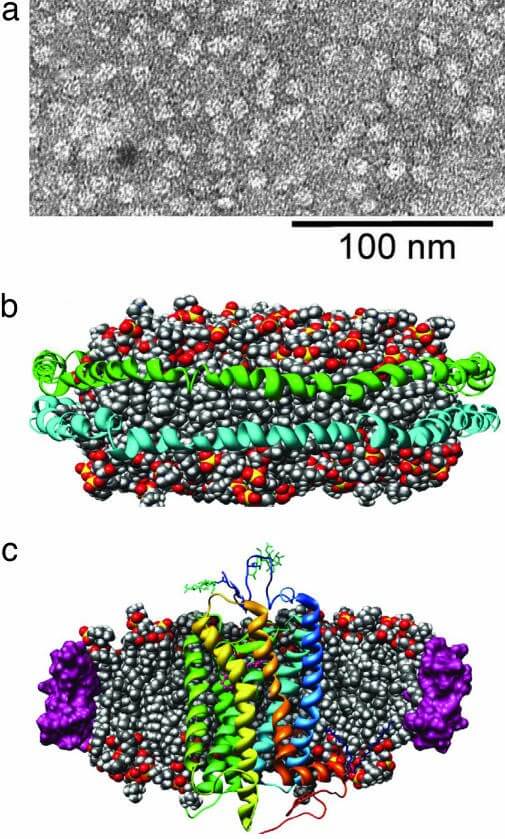Mempro™ Nanodisc for Receptor Studies
Creative Biostructure has made a lot of efforts in exploring the use of Mempro™ Nanodisc technology in membrane protein production and research during the past years, making us in the leading place to apply nanodisc technology on receptor studies.
 Figure 1. TEM of negatively stained rHDL and molecular model of a GPCR reconstituted into rHDL. (Proc. Natl. Acad. Sci. USA, 2016)
Figure 1. TEM of negatively stained rHDL and molecular model of a GPCR reconstituted into rHDL. (Proc. Natl. Acad. Sci. USA, 2016)
The main goal for Creative Biostructure to develop the Mempro™ Nanodisc platform is to provide an alternative to detergents for solubilizing membrane proteins in a functional state. This is achieved by the phospholipid core of the nanodisc particle, which provide a lipid environment that is able to stabilize membrane proteins in solution.
Membrane proteins, especially a lot of receptors, represent an outsized category of important pharmaceutical targets. There is a major challenge to understand the structure and function of these receptors, which has been the inaccessibility of an easy and reproducible system to analyze membrane proteins in a well-controlled and predefined oligomeric states. Mempro™ Nanodisc technology has currently been used to investigate the impact of receptor oligomerization on binding interactions of G protein-coupled receptors (GPCRs), bacterial chemoreceptor and the cholera toxin receptor ganglioside GM1.
The biggest and the most important receptor superfamilies in human genome are the GPCRs, and they are considered as promising drug targets. The GPCRs are characterized to interact with a variety of ligands, and they play a crucial role in mediating various cellular responses including the senses of smell, taste, and light. To overcome the technical limitations in GPCRs studies, Creative Biostructure has introduced our engineering Mempro™ Nanodisc technology to control the desired stoichiometric composition of the homogeneous and monodisperse preparations precisely, allowing us to perform detailed characterization of the oligomeric status of GPCR proteins. Besides receptors, other membrane proteins to form channels and transporters can also be incorporated into nanodiscs for structural and functional studies.
Including but not limited to receptor studies, Mempro™ Nanodisc platform can be also applied on a wide range of membrane proteins research fields, such as structural investigations, ligand-binding studies, protein-lipids interaction, and phage display, etc. Please feel free to contact us for a detailed quote, we are confident to provide the best nanodisc products and custom services.
References:
G. Denisov, et al. (2016). Nanodiscs for structural and functional studies of membrane proteins. Nature Structural & Molecular Biology, 23: 481-486.
J. Borch and T Hamann. (2009). The nanodisc: a novel tool for membrane protein studies. Biol. Chem., 390: 805–814.
M. R. Whorton, et al. (2007). A monomeric G protein-coupled receptor isolated in a high-density lipoprotein particle efficiently activates its G protein. Proc. Natl. Acad. Sci.104(18): 7682-7687.